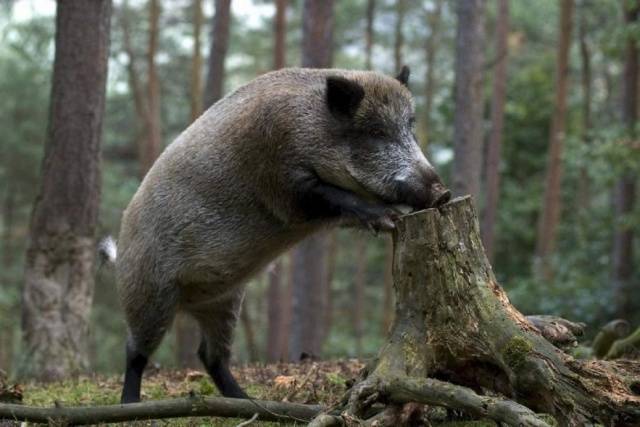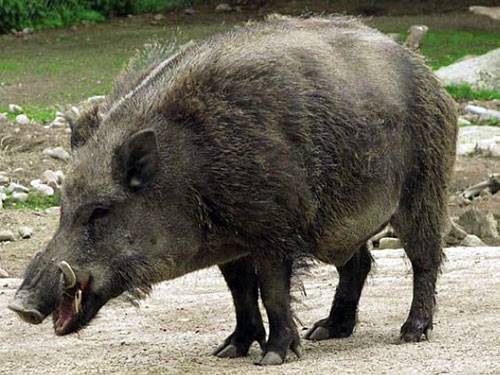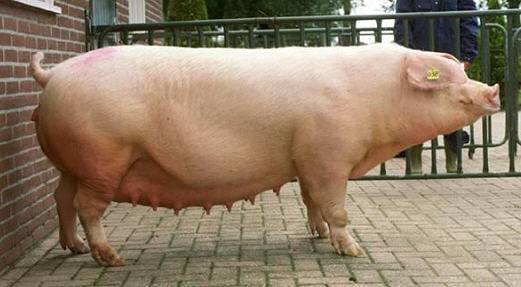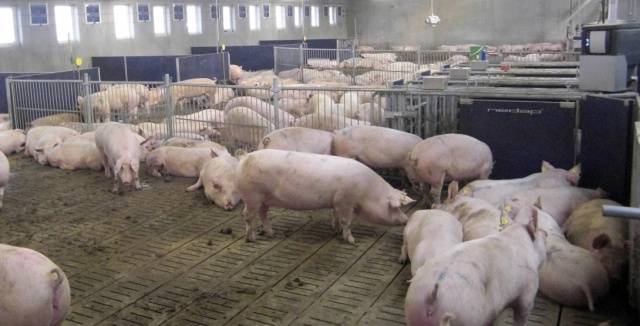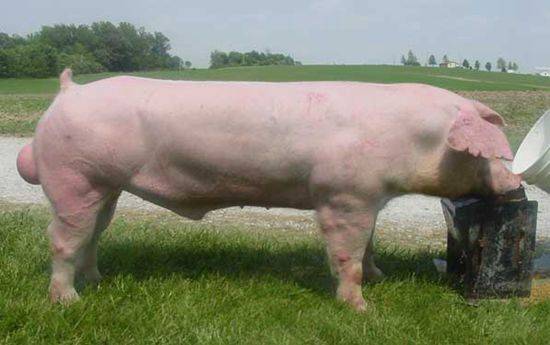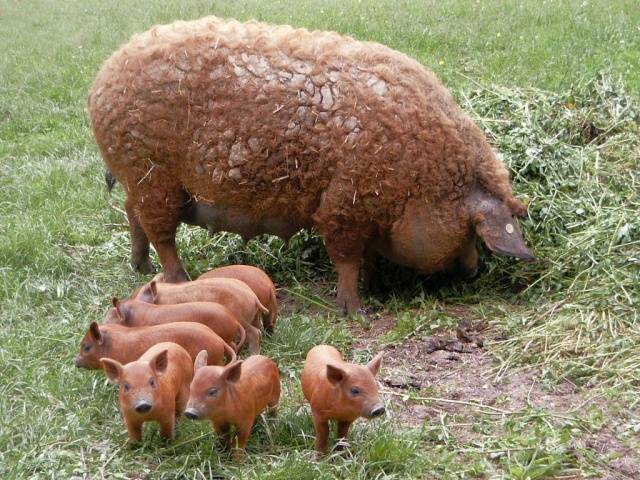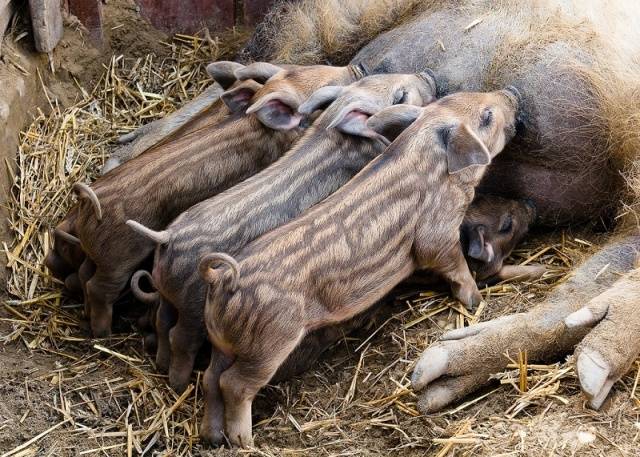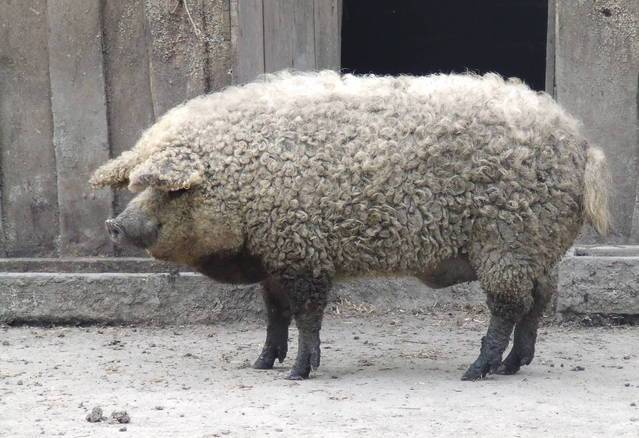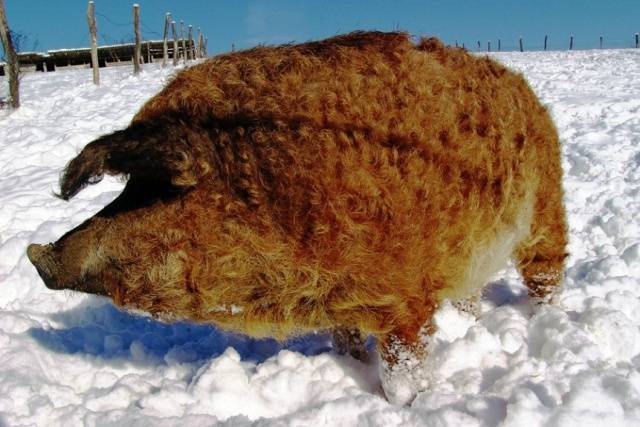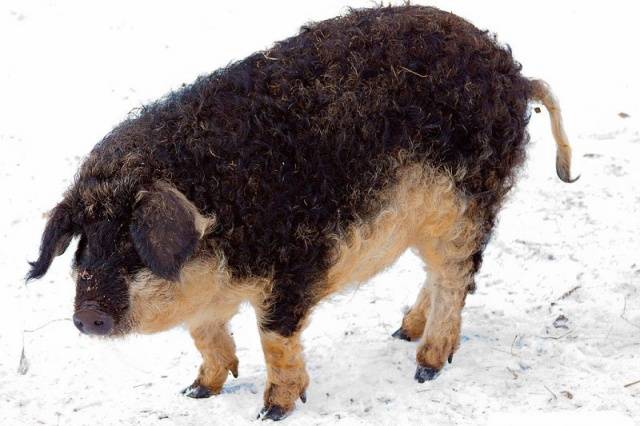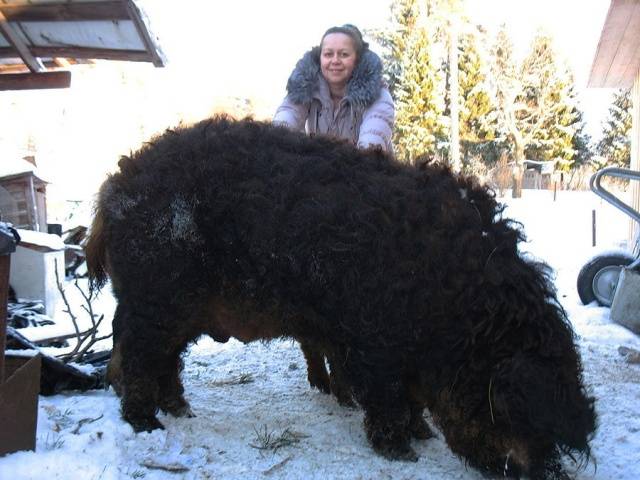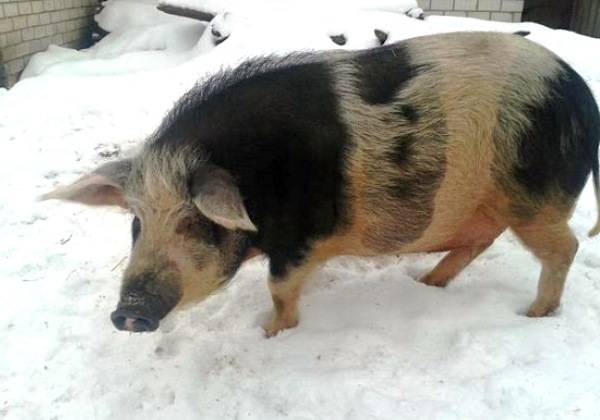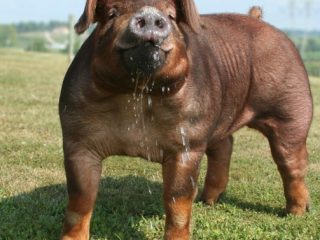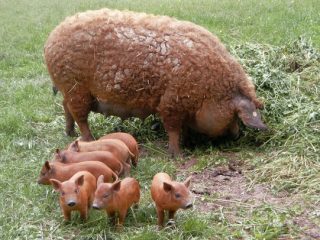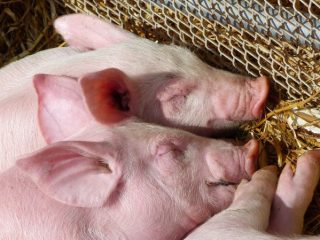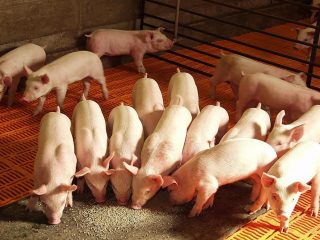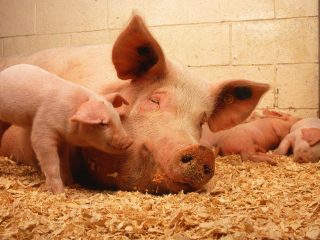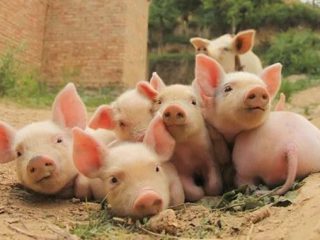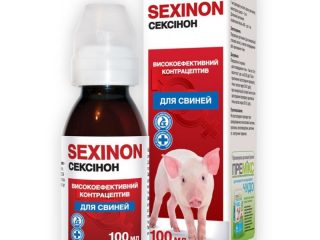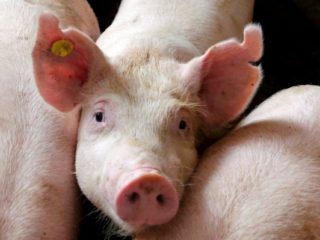Content
The domestication of the modern pig followed complex paths. The remains of pigs that clearly lived alongside people in Europe are found in layers dating back to the 10th century BC. e. In the Middle East, in Mesopotamia, pigs were kept in a semi-wild state already 13,000 years ago. At the same time, pigs were domesticated in China. But the data there differs. Either 8,000 years ago, or 10,000. There is no doubt that the first truly domesticated, and not semi-wild, pigs were brought to Europe from the Middle East.
Apparently, this greatly hurt the pride of the Europeans of that time and stimulated the domestication of the wild European boar. Middle Eastern pigs were soon driven out of Europe and European breeds were introduced to the Middle East.
During the process of domestication, pigs went through several stages of complex crossbreeding between European and Middle Eastern pigs, and in the 18th century, Asian pigs were added to the mix.
Thanks to the endurance, unpretentiousness and omnivorous nature of pigs, primitive man easily domesticated them. Moreover, in fact, the use of pigs has not changed at all since then. Both in primitive times and now, pigs are bred for meat, skins and bristles for brushes. Only if earlier shields were covered with pig skin, today shoes and leather clothes are made from it.
Pigs are an invasive species.Thanks to man, they came to the American continents, escaped, went wild and began to damage the economy of the American aborigines. However, not only American ones. They were also noted in New Zealand and Australia.
The aborigines of any continent were not happy about the appearance of such an animal in their homeland. The pig, in general, is one of the first in terms of adaptability. It is not without reason that scientists believe that after the next global extinction of mammals, the pig will survive and adapt to new conditions. Just like she adapted to life in South America and Australia.
Since the European pig is, in fact, a hybrid of a domesticated pig with a European wild boar, having escaped into the wild, the European pig quickly returned to its original form, becoming, as in Europe, one of the most dangerous inhabitants of the forest.
In the photograph, the Brazilian "javoporco" is a European pig that went wild several centuries ago.
Today, the main purpose of a pig, as before, is to provide humans with meat and lard, as well as “related products”: skin and bristles. But humanity has grown fat and stopped looking at pigs solely as a source of food, and to the three groups of pig breeds: meat, lard and bacon, a fourth was added - mini-pigs, intended to be pets.
All pig breeds are divided into 4 groups:
- meat-fat (universal);
- meat;
- greasy;
- decorative pets.
The last group in Russia is still exotic.
There are more than 100 “pig” breeds in the world, and the pig breeds bred in Russia occupy only a small part of the total population. Moreover, 85% of the total Russian pig population is large white.
The main breeds of pigs in Russia today are: large white (this is the livestock of pig farms), landrace and the increasingly popular Vietnamese pot-bellied pigs. The remaining breeds, unfortunately, are declining in numbers.
Main breeds of pigs
Large white
She's a big white one. Bred in England in the 19th century by mixing quite a large number of European and Asian breeds. At first it was called Yorkshire and only later the name Great White was attached to this breed.
This is a universal type breed. Essentially, what is now called broilers. It grows quickly, reaching 100 kg within six months by the time of slaughter. Adult boars weigh up to 350, sows up to 250.
The first pigs of this breed began to penetrate into Russia at the end of the 19th century. They were imported by landowners and this breed did not have an impact on the state of pig farming in Russia at that time.
Today these pigs are everywhere. To a large extent, this was facilitated by the massive import of the large white breed of pigs in the 20s of the 20th century. It was necessary to quickly feed the population after the devastation of the Civil War.
During the development of the breed, its purpose changed several times. Since lard, when consumed, provides maximum energy with minimal volumes, at first preference was given to pigs that quickly gain weight due to lard deposition. At that time, animals weighing more than 400 kg were valued.
After the market became saturated with food products and the fashion for a healthy lifestyle emerged in England, the demand for lean pork increased. And the great white was “repurposed” for gaining muscle mass at the expense of size and the ability to store subcutaneous fat. The size of the animals became less important.
The Great White stands out from the orderly distribution of pig breeds by direction, since within the breed itself there are lines of meat-fat, meat and fat breeding. Thus, the Great White could replace all other breeds, if not for its certain demands on maintenance, in particular, the presence of a warm pigsty in winter.
During breeding in the USSR, the Great White acquired qualities different from its English ancestors. Today, with formal purebred breeding on the territory of the former Union, essentially a new breed is being raised, distinguished by greater adaptability to Russian conditions and a high ability to adapt to various climatic zones of Russia.
Russian Great Whites have a stronger constitution than modern English pigs of this breed. “Russians” are a universal type and weigh from 275 to 350 kg for boars and 225 to 260 kg for sows. Russian Great Whites are recommended for breeding as a factory breed in all regions of the country, but are not very suitable for breeding by private owners, as they do not tolerate heat and cold well.
Landrace
A breed of meat-type pig developed in Denmark at the turn of the 19th and 20th centuries by crossing a local breed of pig with a Great White. As a factory breed, Landrace is demanding in terms of maintenance conditions. Russian Landraces are similar in size and weight to the Great White breed, but look more slender. A Landrace boar weighs up to 360 kg with a body length of 2 m, and a sow weighs 280 kg with a length of 175 cm.
Landraces are widely used for breeding other breeds of pigs, as well as for broiler lines, using heterotic crossing with pigs of other breeds.
It is believed that Landrace is widespread throughout Russia, but in comparison with the population of large white pigs, Landrace is very small.
Factory pigs are very responsive to feed, and in private farms it would be possible to get by only with them, if not for the capriciousness of these breeds of pigs in relation to the climate and feed.
For home breeding in private household plots, relatively little-known and scarce breeds are much better suited: Mangalitsa and Karmal.
If the mangalitsa is even more or less known and Vietnamese pot-bellied pigs are even sometimes confused with it (although they have nothing in common except the hooves), then the karmal is a new hybrid, recently bred by breeders by crossing the mangalitsa and the pot-bellied pig.
To get a complete picture of what the animals look like, you need to describe these frost-resistant breeds of pigs with photos, and preferably with videos.
Mangalitsa
This is a lard type breed, so lovers of lard with garlic should get a Mangalitsa. In addition to “supplying” lard to owners, Mangalitsa has a number of advantages over factory breeds. She is unpretentious in food and does not require the construction of a major warm pigsty, being content with shelter from the wind even in 20-degree frosts.
History of the breed
Mangalitsa was bred in the first third of the 19th century in Hungary by crossing a domestic pig with semi-wild Carpathian pigs. The set goal: to obtain a breed of pigs that is not afraid of cold weather and unpretentious in food, was successfully completed.
With such a successful result, Mangalitsa quickly gained popularity and they tried to breed it in Transcarpathia and England. In Transcarpathia, mangalitsa took root, but not in England, since English producers, who by that time had flooded the European markets with pork from meat breeds, had no use for the tallow breed of pigs. The number of Mangalitsa began to decline, also in Hungary. By the 90s of the 20th century, the Mangalitsa had practically disappeared and the Hungarian Pig Breeders Association had to take urgent measures to save the breed.
There was also a rescue. The current number of pigs of the breed Hungarian mangalica is already more than 7,000.
The unpretentiousness of Mangalitsa interested Russian pig breeders and Mangalitsa was brought to Russia.
But you can’t buy a Mangalitsa pig cheaply, since it’s difficult to find flaws in the breed. Actually, there is only one: infertility. Mangalitsa does not have more than 10 piglets. Due to the price and low fertility, unscrupulous sellers may be tempted to sell crossbred piglets. Therefore, you need to know the distinctive features of the breed that are unique to the Mangalitsa.
Description of the breed
The first thing that catches your eye is the thick curly coat of the Mangalitsa. But such hair can also be found in a crossbred pig with a large proportion of Mangalitsa blood.
Additional signs of purebred Mangalitsa:
- a small spot up to 5 cm in size on the lower edge of the ear, called Wellman's spot;
- ears point forward;
- open areas of skin: in the area of the snout, eyes, hooves, nipples, anus - must be black. A different skin color indicates a crossbreed;
- little piglets have stripes on their backs, like wild boars;
- pigs are capable of changing coat color depending on feeding and living conditions;
- Seasonal shedding in these pigs is hardly noticeable due to the long process, but piglets in the summer darken due to the loss of winter undercoat, as the black skin begins to show through a little.
Today, only 4 colors are recorded in the Mangalitsa standard.
Fawn, which can be lightened to white.
Red or red.
"Martin".
Very rare and almost extinct black.
Such crossbreeds are not friendly and can be dangerous.
The weight of Mangalitsa is low compared to other pigs, but by the age of 6 months, Mangalitsa piglets gain 70 kg.
Defects of the Mangalitsa breed:
- white skin with well-defined spots;
- dark spots on the coat;
- striped or completely white hooves;
- pink skin near the nipples;
- red tassel on the tail.
These signs indicate that this is a crossbred pig.
First wintering of Hungarian Mangalitsa:
Karmal
A newly bred hybrid of two breeds of pigs: the Hungarian Mangalitsa and the Vietnamese pot-bellied pig. Moreover, the hybrid is so new, rarely widespread and little known that if you have to look at the photographs and think whether it’s a bug or not, at least there are photographs. It's just a problem with the video. Many owners think that it is enough to cover the mangalitsa with a Vietnamese boar or vice versa, as the sow will give birth pockets. In reality, everything is different. A cross between a mangalitsa and a Vietnamese pot-bellied pig will be born. In order for this cross to become a karmal, breeding work is needed to consolidate the traits desired for this hybrid.Therefore, most often in the video it is not pockets, but crosses.
From Mangalitsa, karmals inherited the frost resistance, unpretentiousness to living conditions and immunity of wild boar. From Vietnamese pigs early maturity, multiple births, well-developed maternal instinct, the ability to quickly gain weight and meat production. Just like the Vietnamese, they either do not store fat, or store it strictly under the skin, and such fat is easy to cut off, resulting in lean pork.
In a year, a karmal gains 100 kg of weight, and by two years it is capable of doubling this figure.
The colors of carmals are very diverse, which is explained by the different colors of the parent breeds.
The Karmals took their friendliness and calm disposition from Vietnamese pigs, but their reluctance to mischief is clearly from the Mangalitsa.
Conclusion
The owner of the private farm decides which breed of pig to choose. Some people buy a piglet for their meat, preferring the Landrace or Great White. Others want to sell piglets. Then a lot will depend on the current fashion for the breed of pigs. The passion for Vietnamese pot-bellied fish is already fading. These pigs became familiar, and the myth about the cute domestic pig turned out to be a myth. And today, Vietnamese pigs are bred for meat with pleasure, not deluded by the opportunity to keep a pig of this size in an apartment.
But it seems that the passion for mangalitsa is gaining momentum due to their unusual fluffy appearance and minimal requirements for comfort. Of course, you can’t take a mangalitsa into an apartment either; for an apartment you need a real miniature pig, but these have not yet taken root in Russia.
